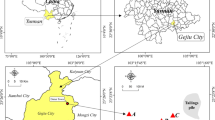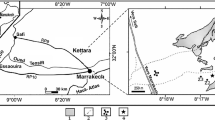Abstract
Differences in the culturable fractions of total and metal-tolerant bacteria inhabiting bulk soil of a metal-mine spoil heap and the rhizosphere of silver birch (Betula pendula) or bushgrass (Calamagrostis epigejos), completed with changes in total microbial community structure in the soil, were assessed by MIDI-FAME (fatty acid methyl ester) profiling of whole-cell fatty acids. In addition, the abundance of metal-tolerant populations among the culturable bacterial communities and their identity and the metal-tolerance patterns were determined. The high proportions of Cu- and Zn-tolerant bacteria that ranged from 60.6% to 94.8% were ascertained in the heap sites. Within 31 bacterial isolates obtained, 24 strains were Gram-positive and Arthrobacter, Bacillus, Rathayibacter, Brochothrix, and Staphylococcus represented those identified. Minimum inhibitory concentration (MIC) data indicated that several strains developed multi-metal tolerance, and the highest tolerance to Cu (10 mM) and Zn (12 mM) was found for Pseudomonas putida TP3 and three isolated strains (BS3, TP12, and SL16), respectively. The analysis of FAME profiles obtained from the culturable bacterial communities showed that Gram-positive bacteria predominated in bulk soil of all heap sites. In contrast, the rhizosphere communities showed a lower proportion of the Gram-positive group, especially for silver birch. For the total microbial community, mostly Gram-negative bacteria (e.g., Pseudomonas) inhabited the heap sites. The results suggest that the quantitative and qualitative development of heterotrophic microbiota in the soil of the metal-mine spoil heap seems to be site-dependent (i.e., rhizosphere vs. bulk soil), according to differences in the site characteristics (e.g., enrichment of nutrients and total metal concentrations) and impact of plant species.



Similar content being viewed by others
References
Bååth, E., Frostegård, A., & Fritze, H. (1992). Soil bacterial biomass, activity, phospholipid fatty acid pattern and pH tolerance in an area polluted with alkaline dust deposition. Applied and Environmental Microbiology, 58, 4026–4031.
Bååth, E. M., Díaz-Raviña, M. R., & Bakken, L. R. (2005). Microbial biomass, community structure and metal tolerance of a naturally Pb-enriched forest soil. Microbial Ecology, 50, 496–505.
Belimov, A. A., Hontzeas, N., Safronova, V. I., Demchinskaya, S. V., Piluzza, G., Llitta, S., et al. (2005). Cadmium-tolerant plant growth-promoting bacteria associated with the roots of Indian mustard (Brassica juncea L. Czern.). Soil Biology and Biochemistry, 37, 241–250.
Brim, H., Heuer, H., Krögerrecklenfort, E., Mergeay, M., & Smalla, K. (1999). Characterization of the bacterial community of a zinc-polluted soil. Canadian Journal of Microbiology, 45, 326–338.
Bruins, M. R., Kapil, S., & Oehme, F. W. (2000). Microbial resistance to metals in the environment. Ecotoxicology and Environmental Safety, 45, 198–207.
Chien, C., Kuo, Y., Chen, C., Hung, Ch, Yeh, C., & Yeh, W. (2008). Microbial diversity of soil bacteria in agricultural field contaminated with heavy metals. Journal of Environmental Sciences, 20, 359–363.
Dang, Z., Liu, C., & Haigh, M. J. (2002). Mobility of heavy metals associated with natural weathering of coal mine spoils. Environmental Pollution, 118, 419–426.
Delorme, T. A., Gagliardi, J. V., Angle, J. S., & Chaney, R. L. (2001). Influence of the zinc hyperaccumulator Thlaspi caerulescens L. and the nonmetal accumulator Trifolium pratense L. on soil microbial populations. Canadian Journal of Microbiology, 47, 773–776.
Díaz-Raviña, M., & Bååth, E. (1996). Development of metal-tolerance in soil bacterial communities expose to experimentally increased metal levels. Applied and Environmental Microbiology, 62, 2970–2977.
Ehrlich, H. L., (1997). Microbes and metals. Applied Microbiology and Biotechnology, 48, 687–692.
Ellis, R. J., Morgan, P., Weightman, A. J., & Fry, J. C. (2003). Cultivation-dependent and -independent approaches for determining bacterial diversity in heavy-metal-contaminated soil. Applied and Environmental Microbiology, 69, 223–3230.
Frostegård, A., Bååth, E., & Tunlid, A. (1993). Shifts in the structure of soil microbial communities in limed forests as revealed by phospholipid fatty acid analyses. Soil Biology and Biochemistry, 25, 723–730.
Frostegård, A., Tunlid, A., & Bååth, E. (1996). Changes in microbial community structure during long-term incubation in two soils experimentally contaminated with metals. Soil Biology and Biochemistry, 28, 55–63.
Germida, J. J., & Siciliano, S. D. (2001). Taxonomic diversity of bacteria associated with the roots of modern, recent and ancient wheat cultivars. Biology and Fertility of Soils, 33, 410–415.
Giller, K. E., Witter, E., & McGrath, S. P. (1998). Toxicity of heavy metals to microorganisms and microbial processes in agricultural soils: a review. Soil Biology and Biochemistry, 30, 1389–1414.
Hattori, H. (1992). Influence of heavy metals on soil microbial activities. Soil Science and Plant Nutrition, 38, 93–100.
Hattori, T., Mitsui, H., Haga, H., Wakao, N., & Shikano, S. (1997). Advances in soil microbial ecology and the biodiversity. Antonie van Leeuwenhoek, 72, 21–28.
He, L. Y., Zhang, Y. F., Ma, H. Y., Su, L. N., Chen, Z. J., & Wang, Q. Y. (2010). Characterization of copper-resistant bacteria and assessment of bacterial communities in rhizosphere soils of copper-tolerant plants. Applied Soil Ecology, 44, 49–55.
Hu, Q., Qi, H., Zeng, J., & Zhang, H. (2007). Bacterial diversity in soils around a lead and zinc mine. Journal of Environmental Sciences, 19, 74–79.
Ibekwe, A. M., & Kennedy, A. C. (1998). Phospholipid fatty acid profiles and carbon utilization patterns for analysis of microbial community structure under field and greenhouse conditions. FEMS Microbiology Ecology, 26, 151–163.
Kelly, J. J., Häggblom, M. M., & Tate, R. L. (2003). Effects of heavy metal contamination and remediation on soil microbial communities in the vicinity of a zinc smelter as indicated by analysis of microbial community phospholipids fatty acid profiles. Biology and Fertility of Soils, 38, 65–71.
Khan, M., & Scullion, J. (2000). Effect of soil on microbial responses to metal contamination. Environmental Pollution, 110, 115–125.
Kidd, P., Barceló, J., Bernal, M. P., Navari-Izo, F., Poschenrider, C., Shilev, S., et al. (2009). Trace element behaviour at the root-soil interface: Implications in phytoremediation. Environmental and Experimental Botany, 67, 243–259.
Kozdrój, J. (1995). Microbial responses to single or successive soil contamination with Cd or Cu. Soil Biology and Biochemistry, 27, 1459–1465.
Kozdrój, J. (2000). Microflora of technogenous wastes characterized by fatty acid profiling. Microbiological Research, 155, 149–156.
Kozdrój, J., & van Elsas, J. D. (2001). Structural diversity of microbial communities in arable soils of a heavily industrialized area determined by PCR-DGGE fingerprinting and FAME profiling. Applied Soil Ecology, 17, 31–42.
Kozdrój, J., Trevors, J. T., & van Elsas, J. D. (2004). Influence of introduced potential biocontrol agents on maize seedling growth and bacterial community structure in the rhizosphere. Soil Biology and Biochemistry, 36, 1775–1784.
Kozdrój, J. (2008). Microbial community in the rhizosphere of young maize is susceptible to the impact of introduced pseudomonads. The Journal of General and Applied Microbiology, 54, 205–210.
Kuffner, M., Puschenreiter, M., Wieshammer, G., Gorfer, M., & Sessitsch, A. (2008). Rhizosphere bacteria affect growth and metal uptake of heavy metal accumulating willows. Plant and Soil, 304, 35–44.
Kunito, T., Kazutoshi, S., Nagaoka, K., Oyaizu, H., & Matsumoto, S. (2001). Characterization of copper-resistant bacterial community in rhizosphere of highly copper-contaminated soil. European Journal of Soil Biology, 37, 95–102.
Ledin, M. (2000). Accumulation of metals by microorganisms—Processes and importance for soil system. Earth Science Reviews, 51, 1–31.
Lorenz, N., Hintemann, T., Kramarewa, T., Katayama, A., Yasuta, T., Marschner, P., et al. (2006). Response of microbial activity and microbial community composition in soils to long-term arsenic and cadmium exposure. Soil Biology and Biochemistry, 38, 1430–1437.
Malik, A., Khan, I. F., & Aleem, A. (2002). Plasmid incidence in bacteria from agricultural and industrial soils. World Journal of Microbiology & Biotechnology, 18, 827–833.
Microbial ID Inc. (1999). Microbial Identification System Operating Manual, Version 7. Newark, Delaware.
Monchy, S., Mohammed, A., Benotmane, M. A., Janssen, P., Vallaeys, T., Taghavi, S., et al. (2007). Plasmids pMOL28 and pMOL30 of Cupriavidus metallidurans are specialised in the maximal viable response to heavy metals. Journal of Bacteriology, 189, 7417–7425.
Nies, D. H., & Silver, S. (1995). Ion efflux systems involved in bacterial metal resistance. Journal of Industrial Microbiology, 14, 186–199.
Pérez-de-Mora, A., Burgosa, P., Madejóna, E., Cabreraa, F., Jaeckel, P., & Schloter, M. (2006). Microbial community structure and function in a soil contaminated by heavy metals: Effects of plant growth and different amendments. Soil Biology and Biochemistry, 38, 327–341.
Piotrowska-Seget, Z., Cycoń, M., & Kozdrój, J. (2005). Metal-tolerant bacteria occurring in heavily polluted soil and mine spoil. Applied Soil Ecology, 28, 237–246.
Pennanen, T., Frosetgård, A., Fritze, H., & Bååth, E. (1996). Phospholipid fatty acid composition and heavy metal tolerance of soil microbial communities along two heavy metal polluted gradients in coniferous forests. Applied and Environmental Microbiology, 62, 420–428.
Rajapaksha, R. M. C. P., Tobor-Kapłon, M. A., & Bååth, E. (2004). Metal toxicity affects fungal and bacterial activities in soil differently. Applied and Environmental Microbiology, 70, 2966–2973.
Rajkumar, M., & Freitas, H. (2008). Effects of inoculation of plant-growth promoting bacteria on Ni uptake by Indian mustard. Bioresource Technology, 99, 3491–3498.
Rasmussen, L. D., & Sørensen, S. J. (2001). Effects of mercury contamination on the culturable heterotrophic, functional and genetic diversity of the bacterial community in soil. FEMS Microbiology Ecology, 36, 1–9.
Roane, T. M. (1999). Lead resistance in two bacterial isolates from heavy metal-contaminated soils. Microbial Ecology, 37, 218–224.
Roane, T. M., & Kellog, S. T. (1996). Characterization of bacterial communities in heavy metal contaminated soils. Canadian Journal of Microbiology, 42, 593–603.
Renella, G., Mench, M., van der Lelie, D., Pietramellara, G., Ascher, J., Ceccherini, M. T., et al. (2004). Hydrolase activity, microbial biomass and community structure in long-term Cd-contaminated soils. Soil Biology and Biochemistry, 36, 443–451.
Ryan, R. P., Ryan, D. J., & Dowling, D. N. (2005). Multiple metal resistant transferable phenotypes in bacteria as indicators of soil contamination with heavy metals. Journal of Soil Sediments, 5, 95–100.
Schinner, F., Öhlinger, R., Kandeler, E., & Margesin, R. (1996). Methods in Soil Biology. Springer, Heidelberg Berlin New York.
Schlegel, H. G., Cosson, J. P., & Baker, A. J. M. (1991). Nickel-hyperaccumulating plants provide a niche for nickel-resistant bacteria. Botanical Acta, 104, 18–25.
Schutter, M. E., & Fuhrmann, J. J. (2001). Soil microbial community responses to fly ash amendment as revealed by analyses of whole soils and bacterial isolates. Soil Biology and Biochemistry, 33, 1947–1958.
Tom-Petersen, A., Leser, T. D., Marsh, T. L., & Nybroe, O. (2003). Effects of copper on the bacterial community in agricultural soil analyzed by the T-RFLP technique. FEMS Microbiology Ecology, 46, 53–62.
Van Gronsveld, J., Sterckx, J., van Assche, F., & Clijsters, H. (1995). Rehabilitation studies on an old nonferrous waste dumping ground – effects of revegetation and metal immobilization by beringite. Journal of Geochemical Exploration, 52, 221–229.
Wani, P. H., Khan, M. S., & Zaidi, A. (2008). Impact of zinc-tolerant plant growth-promoting rhizobacteria on lentil grown in zinc-amended soil. Agronomy for Sustainable Development, 28, 449–455.
Zelles, L. (1999). Fatty acid patterns of phospholipids, lipopolysaccharides in the characterization of microbial communities in soil: a review. Biology and Fertility of Soils, 29, 111–129.
Author information
Authors and Affiliations
Corresponding author
Rights and permissions
About this article
Cite this article
Sułowicz, S., Płociniczak, T., Piotrowska-Seget, Z. et al. Significance of Silver Birch and Bushgrass for Establishment of Microbial Heterotrophic Community in a Metal-Mine Spoil Heap. Water Air Soil Pollut 214, 205–218 (2011). https://doi.org/10.1007/s11270-010-0417-x
Received:
Accepted:
Published:
Issue Date:
DOI: https://doi.org/10.1007/s11270-010-0417-x




